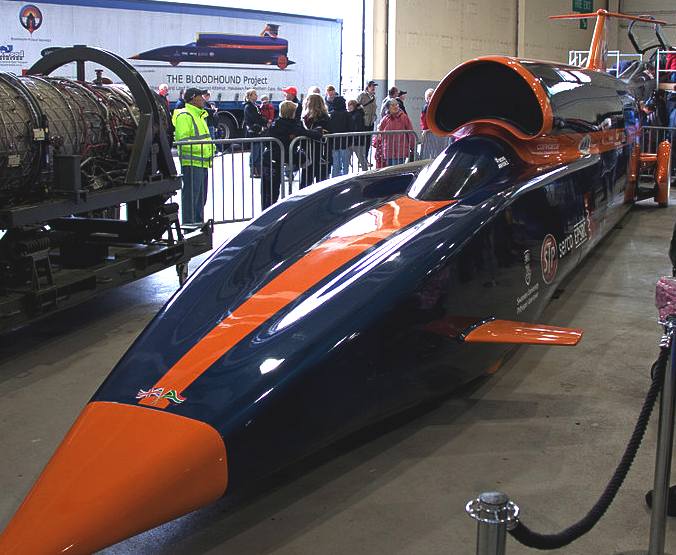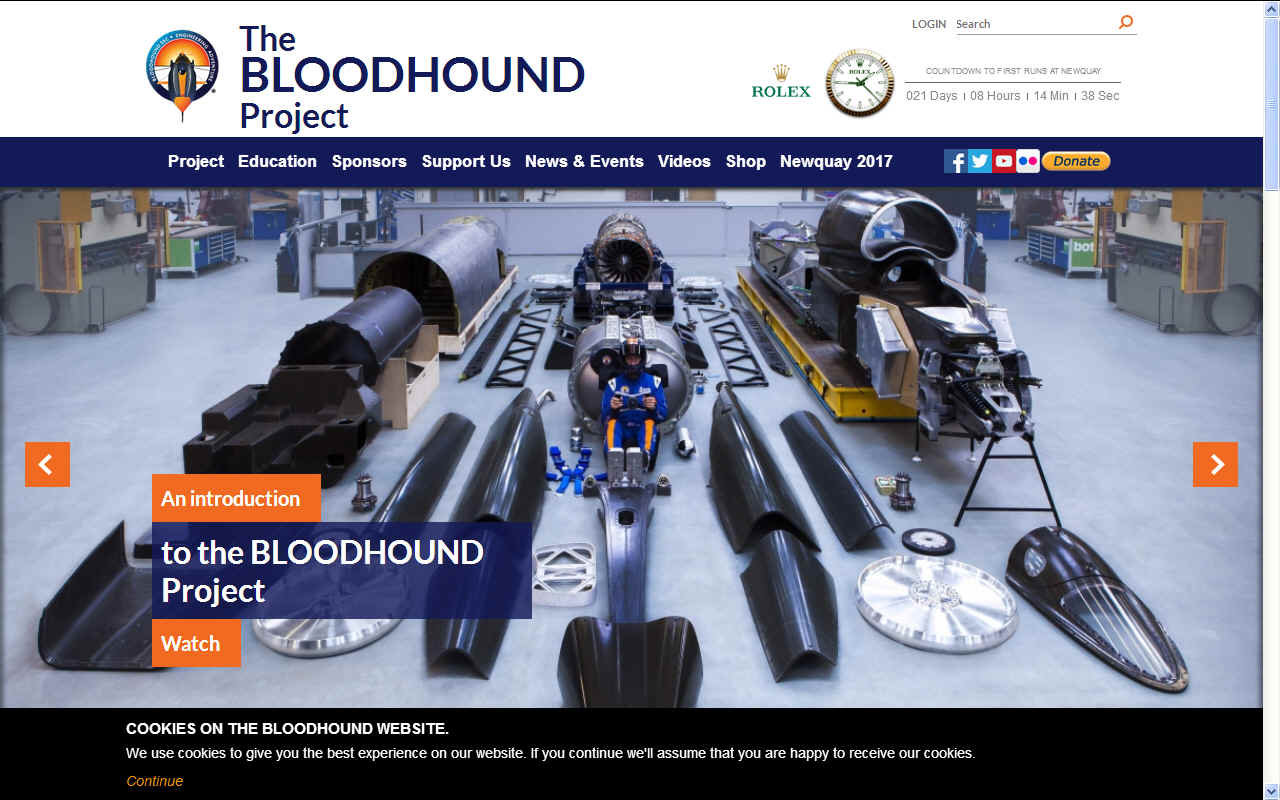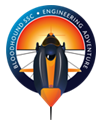|

The BLOODHOUND Project
was spawned from Thrust 2 and Thrust SSC, both projects with Richard
Noble at the helm as the originator of the British land speed record
contingent.
THE
GUARDIAN 15
OCTOBER 2018 - 1,000 MPH CAR HITS SKIDS
Plans to build a British jet-powered car to speed at more than 1,000mph through the desert have hit quicksand, after the company behind the Bloodhound project entered administration.
The dream of an ultra-fast car to break the land speed record led to the creation of Bloodhound Programme Ltd in 2007, with the idea of also engaging schools and students in engineering.
Bloodhound has already built and tested a viable racing car to speeds of 200mph, but the project is in debt and needs to find £25m or face being wound up.
Administrators have appealed for investors, comparing its cost and potential legacy favourably with the money spent on Formula One and other races. So far, Bloodhound has been supported by partners and sponsors including Rolls-Royce and the UK Ministry of Defence, which has loaned prototype jet engines.
The Northern Cape regional government in South Africa has also helped build an 11-mile long (18km), 1,500 metre-wide race track in the desert at Hakskeenpan.
Bloodhound said its programme had been a catalyst for research and development, as well as helping interest schoolchildren worldwide in science and engineering, with an associated educational campaign reaching more than 2 million children.
Andrew Sheridan, a joint administrator at FRP Advisory, said: “Bloodhound is a truly groundbreaking project. Entering into administration provides some breathing space to identify an investor who will bring the guaranteed funding, impetus and expertise required to drive the project forward.”
He said discussions were being held with a number of potential investors. “Whilst not an insignificant amount, the £25m Bloodhound requires to break the land speed record is a fraction of the cost of, for example, finishing last in a F1 season or running an America’s Cup team. This is an opportunity for the right investor to leave a lasting legacy.”
Bloodhound’s chief engineer, Mark Chapman, said: “With the right support we have no doubt that the project will achieve its aims and could be racing for the record in as little as 10 months.”
The planned car is a combination of jet, F1 car and spaceship that would cover the length of four and a half
football pitches in a second.
The current world land speed record of 763mph was achieved in the Nevada desert in 1997 in a UK-designed car, Thrust SSC, led by the same team behind Bloodhound.

BBC
NEWS 15
OCTOBER 2018 - SUPERSONIC CAR HITS FINANCIAL ROADBLOCK
The project to race a car at over 1,000mph has run into a financial roadblock with the company behind the venture going into administration.
The Bloodhound supersonic vehicle is all but built but needs a £25m investment if it is to break records on a dried-out lakebed in South Africa.
The administrators, FRP Advisory LLP, have already begun to talk to potential suitors and want to hear from others.
But without the funds the project faces being wound up in the coming weeks.
Bloodhound is, by any measure, the most sophisticated land speed record car ever conceived.
To be powered by a Rolls-Royce Eurofighter
jet engine bolted to a rocket, it should easily smash the existing world mark of 763mph (1,228km/h). And computer simulations indicate it ought to be capable of going much, much faster still.
But although all the R&D is done, with the car even conducting some low-speed trials - the project simply cannot now move forward into its end phase unless the necessary funding is in place.
"This is the situation," explained Andrew Sheridan from FRP Advisory LLP's Bristol office.
"We have a legal entity that has gone into administration because it hasn't got any more cash. But there is a project there that is very much alive and on the cusp of delivering its goal, which is ground-breaking with leading technology.
"However, it does need circa £25m to get it over the line, and that now requires an investor, be that a wealthy individual or a corporate of some kind," he told BBC News.
WHY IS BLOODHOUND IN FINANCIAL DIFFICULTY?
Bloodhound is a private undertaking. It is funded through donation, sponsorship and partnership. Bloodhound has excelled at leveraging all three, but ultimately this funding model has not delivered sufficient cash to fully sustain such a complex venture.
The last two-to-three years have been an especially tough environment in which to raise financial support. The investment landscape is difficult, in part because of Brexit uncertainty, but principally because many large brands that might once have put their name on the side of a car to build awareness are now using other marketing tools, such as social media.
By going into administration, Bloodhound Programme Ltd, the company behind Project Bloodhound, gets some breathing space to allow it to find a solution.

Richard
Noble, Bloodhound
SSC leader
HOW READY IS BLOODHOUND TO GO RACING?
The main structure of the vehicle is built, and last October Bloodhound conducted shakedown runs, topping 200mph (320km/h) on the runway at Newquay airport in Cornwall.
The track on which it intends to break the land speed record is also ready to host the car. The Northern Cape Government in South Africa has had an 18km-long, 1,500m-wide section of Hakskeen Pan cleared of stones.
And, significantly, the one major element in the technical package that was outstanding has just demonstrated its readiness. This is the rocket that would go in the back of Bloodhound to push it through the sound barrier.
Developed by the Norwegian aerospace and defence company Nammo, it was launched to space for the first time at the end of September. The Nucleus rocket flew to an altitude of 107km from the Andøya Space Center.
Bloodhound would use a cluster of three Nucleus motors in addition to the Eurofighter EJ200 jet.
"Once we have the funding in place, or at least visibility of that funding, and the team is back in the building, then 10 months later we're out in South Africa," said Mark Chapman, Bloodhound's chief engineer. "We're that close. This is a huge opportunity for global exposure. Nammo firing that motor was really important, really impressive."
HOW SOON COULD RECORD ATTEMPTS START?
If the £25m becomes available, Bloodhound could start running on Hakskeen Pan towards the end of 2019, when the lakebed has evaporated the seasonal rains and the ground has become bone dry.
The current plan is to run the car in the first instance in the region of 500-600mph (800-965km/h), using just the Eurofighter jet, to get a better sense of how the car behaves as it approaches the speed of sound.
The team would then wait for another rain season to pass before returning to Hakskeen with the addition of a Nammo motor to raise the land speed record above 800mph, and then ultimately to over 1,000mph. So, that would probably mean running in 2020 and again in 2021.
WHAT ABOUT BLOODHOUND'S EDUCATION PROGRAMME?
Bloodhound was launched in 2008 as a "vehicle" to get children excited about science and engineering, and to persuade them of the benefits of entering technical careers. This STEM campaign was one of the reasons big engineering firms got involved because they saw the project as a means to promote their apprenticeship schemes.
To date, this "education adventure" has reached over two million children, including 120,000 schoolchildren in the UK each year.
The education side of things is unaffected by Monday's news because it is organised as a charity; it has separate sources of income.
The current world land speed record was set in 1997 by the Thrust Super Sonic Car. The UK team behind it was led by Bloodhound's Project Director, Richard Noble. Thrust's driver,
Andy Green, is also the pilot for Bloodhound.
By Jonathan Amos, BBC Science Correspondent

DESIGN,
PRODUCTS & APPLICATION 15 OCTOBER 2018 - INVESTMENT SOUGHT
Project Bloodhound is seeking £25 million from interested parties to provide guaranteed funding that will see the project to completion.
Bloodhound Programme Ltd, the company behind Project Bloodhound, the initiative to break the land speed world record, entered into administration on 15 October 2018 with the appointment of Andrew Sheridan and Geoff Rowley, partners at specialist business advisory firm FRP Advisory LLP, as joint administrators.
Project Bloodhound was founded in 2007 and aims to hit speeds of 1,000mph at a specially built, 18km long, 1,500m wide race track at Hakskeen Pan in the deserts of the Northern Cape of South Africa.
In addition to seeking to break the land speed world record, the project is a major R&D catalyst and the focal point for a
STEM education campaign which has reached over 2 million children since its launch, including 120,000 UK school children per year.
To date the project has operated on a partnership and sponsorship model, with support from a variety of partners including
Rolls-Royce and
Rolex as well as the Ministry of Defence which has lent prototype jet engines for the car, and the Northern Cape Provincial Government in South Africa, which has supported the creation of the track. Individual donations from members of the public have also supported the development of the car and the global education programme.
The project has already successfully built a viable racing car which has been tested to 200mph, whilst developing or testing propulsion, aerodynamic and telecommunications technologies with the potential for far reaching applications outside of the project. The team is now seeking around
£25m in investment to provide guaranteed funding and see the project to completion.
Andrew Sheridan, joint administrator, commented: “Bloodhound is a truly ground-breaking project which has already built a global audience and helped to inspire a new generation of
STEM talent in the UK and across the world. Entering into administration provides some breathing space to identify an investor who will bring the guaranteed funding, impetus and expertise required to drive the project forward.
“Whilst not an insignificant amount, the £25m Bloodhound requires to break the land speed record is a fraction of the cost of, for example, finishing last in a F1 season or running an Americas Cup team. This is an opportunity for the right investor to leave a lasting legacy. We are already in discussion with a number of potential investors and would encourage any other interested party to contact us without delay.”
Mark Chapman, Chief Engineer, Project Bloodhound, commented: “Bloodhound has had enormous success in creating the world’s most advanced land vehicle. As we now move out of the R&D phase and into the operational phase of the project, we recognise that we need a different approach to funding. This project is built around the most successful team in the
history of Land Speed Racing, and with the right support we have no doubt that the project will achieve its aims and could be racing for the record in as little as ten months.”
Interested parties should contact FRP Advisory LLP Bristol office on
0117 203 3700.

The BLOODHOUND Project is the name of an international education initiative focused around a 1,000 mph world land speed
record attempt. The team aim to break the land speed record with a pencil-shaped car called BLOODHOUND
SSC, powered by a jet engine and a rocket
similar to the Budweiser
car, designed to reach 1,000 miles per hour (1,609 km/h). It is being developed and built with the intention of breaking the land speed record by 33%, the largest ever
margin.
Bloodhound
development
DESIGN
The project is/was based in what used to be the Maritime Heritage Centre on the Bristol
harbourside, located next to
Brunel's SS Great Britain. This building has been renamed the Bloodhound Technical Centre.
The College of Engineering at Swansea University has been heavily involved in the aerodynamic shape of the vehicle from the start. Professor Oubay
Hassan, Professor Ken Morgan and their team have used Computational Fluid Dynamics
(CFD) in order to provide an understanding of the aerodynamic characteristics of the proposed shape, at all speeds, including predicting the likely vertical, lateral and drag forces on the vehicle and its pitch and yaw
stability.
This technology, originally developed for the aerospace industry, was validated for a land-going vehicle during the design of Thrust
SSC. It was this involvement with the previous land speed record that prompted
Richard Noble to approach Swansea in April 2007 to see if they could help with this latest challenge. Swansea University's
School of the Environment and Society was also enlisted to help determine a new test site for the record as the test site for the
Thrust SSC record attempt has become
unsuitable.

A prototype Eurojet EJ200 jet engine developed for the Eurofighter and bound for a museum, was donated to the project. This will take the car to 300 mph (480 km/h), after which a bespoke hybrid rocket designed by Daniel Jubb (nicknamed "Rocket Dan"), 27, from Manchester, who built his first rocket at the age of 5, will boost the car up to 1,000 mph (1,600 km/h). A third engine, an 750 hp (560 kW) 2.4 Litre Cosworth CA2010 F1 V8
petrol engine, is used as an auxiliary power unit and to drive the oxidiser pump for the rocket. The jet engine will provide nine tonnes of thrust and the rocket will add another 12. The Super Sonic Car will have roughly the same power as 180
F1 cars.
The four 36-inch (910 mm) diameter wheels will rotate at up to 10,200 rpm and will be forged from solid
aluminium to resist the 50,000 g centrifugal
forces.

DESIGN,
PRODUCTS & APPLICATION 30 SEPTEMBER 2017
The 1,000mph racing car has had its EJ200 jet engine started and taken to max
reheat during its first week of testing at Cornwall Airport, Newquay.
Driver Andy Green sat in the cockpit, throttling the jet engine with his right foot, the car was tied down to a secure anchor.
Data collected from the sensors on the car confirmed the jet engine produced the expected thrust during maximum reheat.
“What a fantastic ending to our first week of testing,” said Stuart Edmonson, Head of Engineering Operations. “integrating a Eurofighter Typhoon
jet engine into the car is a huge challenge; however, we have succeeded!”
“Witnessing the EJ200 jet engine at maximum reheat is a fantastic experience. Not only can you see the shock diamonds and hear the deafening noise, you can physically feel the power of the engine as your body shakes.”
“With the static tests complete the team will move onto dynamic testing, ready for our high speed, 200mph, trials at the end of October.”
Bloodhound
firing up
Thrust
2 |
Thrust
SSC |
Bloodhound
SSC
Aussie
Invader 5R
SSC
LINKS
https://www.bbc.co.uk/news/science-environment-45838994
https://www.theguardian.com/technology/2018/oct/15/bloodhound-1000mph-car-hits-skids-project-enters-administration
Swansea
University Desert Selection Programme
Home
http://www.dpaonthenet.net/article/162543/Investment-sought-to-break-land-speed-world-record.aspx#
http://www.dpaonthenet.net/article/139905/Start-your-engines--BLOODHOUND-s-jet-engine-fired-up.aspx

|








